Porcelain Insulator News
by Jack H. Tod
Reprinted from "INSULATORS - Crown Jewels of the Wire", December 1974, page 21
Preferably direct porcelain news item and questions directly to Jack H. Tod,
3427 N. 47th Place, Phoenix, Ariz. 85018. All mail will be answered if reply
stamp is enclosed, and the most newsworthy items and questions of general
interest will be published an space permits.
Listed below are the porcelain dry press markings which have accumulated
since the last listing of these in the February 1974 issue. About half of these
are attributions for previously listed markings. The collector reporting the new
ones or attributing others is shown for
each item with the following keying:
-
(1) Mike Barbieri
- (2) Walter Lehnert
- (3) Carl Lencse
- (4) Fred Richardson
| AJAX |
Ajax Elec Spclty Co, St. Louis, radio (2) |
 |
Amer Porc Co. E. Liverpool,
O., std pore (3) |
| B. E. CO. |
Bryant Elec Co, Bridgeport, Conn., spcl (3) |
| BEAVER |
Beaver Mach & Tool Co, Newark, spclty (2) |
| C. C. E. |
unattributed, #334 wiring cleats (9) |
| CORWICO |
Cornish Wire Co. New York, radio
insuls.(2) |
| D & S P Co. |
Davidson & Stevenson Porcelain Co.,
East Liverpool, Ohio,
standard porcelain (3) |
| D & S |
ditto (3) |
| EAGLE |
Eagle Elecl Mfg Co, L.I. City, NY, radio (2) |
| GUARDIAN |
The Muter Co., Chicago, radio ant. insul (2) |
| HARDWICK HINDLE INC. |
of Newark, N.J., spclty item (2) |
| HECO |
Heineman Elec Co, Phila , radio ant. (1) |
| Isolantite Mfg Co. |
of Stirling, N.J., radio & spcl (9) |
| J.H,P. & S. |
J. H. Parker & Son, Parkersburg, W. Va. (3) |
| ROCK |
unattributed, #334 wiring cleats (2) |
| R R |
Radio Receptor Co, NY City, radio item
(2) |
| SENSORY |
Heineman Elec Co, Phila., radio ant. (1) |
| The Solderall Co. |
of Newark, N.J., radio ant.
insuls. (2) |
| T.T.P. Co. |
The Trenle Pore Co, E
Liverp'l, std pore. (3) |
 |
Monogram-WS, unattributed,
#334 cleats (3) |
 |
unattributed, early wiring cleats (4) |
 |
unattributed, early wiring cleats (4) |
 |
Arrow Elec Co, Hartford,
Conn, spelty (3) |
THOSE MLOD PITTSBURG INSULATORS
Pittsburg High Voltage Insulator Co., Derry, Pa. was established in 1908 and
was ultimately wholly owned by Westinghouse by 1922. They cataloged a very large
number of pin type styles, more than any other company, and tended to go after
the "short order" business other companies didn't really care for.
Pittsburg not only made many types of special designs for customers and applied
customer markings on many different items, but they also made foreign styles for
export overseas and quite a variety of beehive and other styles for Canadian
railroad companies.
One other thing sets Pittsburg apart from all the other U.S. insulator
manufacturers, and that is the fact that many of their styles, all wet process
items, were made in two-part forming press molds. On these items, a Mold Line
Over Dome is continuous from one base rim all the way up over the insulator and
down to the other side of the base.
This manufacturing method allowed them to make unusual shapes such as the
"eared" types U-393 and U-395 by the wet process, and a byproduct of
the method was that any side grooves could be included in the parting-type mold
and did not have to be cut in after pressing by "green trimming"
operations.
Evidently Pittsburg got carried away with this idea of eliminating the extra
trimming operation, and they made many very ordinary styles by this method. I
have noted at one time or another all the following Pittsburg styles with MLOD:
U-5, 42B, 42C, 68, 73, 81, 84, 106, 110, 117, 149A, 154, 202A, 224, 230, 243,
265, 359, 361, 377, 393, 393A, 395, 410, 438A, 499, 529, 540 and U-570.
Some of these Pittsburg MLOD insulators I have seen which were from actual
use on lines showed flaws associated with the mold line, and the Pittsburg
dumpage was full of many insulators which cracked at the mold line during
firing. Being ever more curious about the whys and wherefores of Pittsburg's
methods in view of the basic fault in this manufacturing process, I some time
ago quarried John Stout, plant manager of McGraw-Edison's insulator plant at
Macomb, Ill. His reply, in part was:
"... I think you are right in the idea that this was a method ... to get
special shapes as long as there are no undercuts in one operation. I have made
insulators by the dry process by this procedure and some experience in pressing
wet process clay by the same technique.
"As you know, ceramic materials from which insulators are made are not
spherical particles but a combination of plates and particles in which one axis
is longer than the other. During a forge type pressing of a plastic body these
particles are highly oriented at the parting line where the excess clay escapes
and the dies come together. A differential shrinkage occurs at the parting line
resulting in cracks and a plane of weakness relative to electrical and
mechanical strength. Just trimming of the flush line is not sufficient to remove
this weakness. We find that in pressing plastic clay the parting line of the two
dies must be moved to one end or a side and not part within the body surface of
an insulator. It is for this reason the type operation to which you describe has
never been popular."
This peculiar characteristic of most Pittsburg insulators, together with
several other factors, allows us to readily attribute virtually every Pittsburg
specimen to that company, although only one specimen is known which is actually
marked "Pittsburg" (reported in this column in October 1973)!
Any wet process pin type with this complete two-part mold line is a
Pittsburg, but be careful in that some dry process types with mold lines (never
made by Pittsburg) are so well made as to deceptively approach wet process
quality and appearance. The mold line on the Pittsburg is always carved off with
a wishbone tool or otherwise fettled down flush with the surface, and it may
even be indistinguishable on specimens with a heavy, dark glaze.
As another attribution aid, Pittsburg cataloged many of their peculiar
styles, and these are noted in my book in the checklist of confirmed
manufacturers of the 900+ styles in the Universal Style Chart. Furthermore, dump
digging at Derry has confirmed Pittsburg manufacture of many styles made by no
other company.
Yet another method is that we have verified by plant dumpage and other
factors that all the date code items (such as May 17 P.M.) were made by
Pittsburg, plus all the full date (June 23, 1915) items in the 1911-1915 era,
plus all item with the following customer markings: SOO, P.R.R., POSTAL,
N.A.T.Co. and the U-241A specimens marked JOHNS-MANVILLE.
And there is one real clincher which gives away all Pittsburg pin types, and
most collectors are aware of this. The top of the pin hole is always either (1)
perfectly flat or (2) some combination of concentric circles, a typical one
being as illustrated at the right. I've looked up in the pin holes of literally
thousands of insulators of all manufacturers and have never found any which have
this Pittsburg feature -- excluding dry process types, of course, some of which do
have flat topped pin holes.

Experienced collectors can also tell a Pittsburg insulator nine times out of
ten just by its glaze. They always had a very richly colored glaze including
walnut browns, reddish-mahogany, beautiful carmels banded with darker browns and
an unmistakable bright baby blue. To date I have never seen a Pittsburg in
cobalt blue, green, gray or yellow.
Yes, Pittsburg was different from the other companies in many ways, and some
collectors choose to specialize in Pittsburg for that reason -- even though
virtually all of their pet specimens are unmarked.
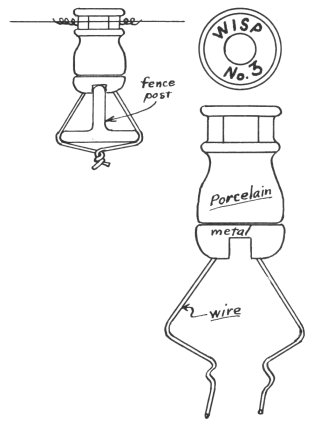
Dear Jack:
I am sending to you a couple of little insulators I found in a dump on an old
ranch near Hardin, Montana.
I have never seen anything like these so was interested, of course. Any
information you might have would be appreciated. Enjoy your articles in C.J.
John L. Schall
Santa Paula, Cal.
- - - - - - - - -
Dear John:
These are special electric fence insulator knobs made by Wisconsin Porcelain
Co., Sun Prairie, Wis. They used markings WP, WIS-P and a tradename WISP as on
these items. The No. 3 is their catalog number for this.
This one is meant for use on standard steel posts as I've shown in the sketch
above left. Thus, the wire pigtails to secure it to the post.
You will note on page 163 of Gerald Brown's second edition of
"Collectible Porcelain Insulators" an identical WISP porcelain item
but with a bottom insert having a nail assembly instead of the wire pigtail, and
that one was for use on wooden posts. These bottom attachments screw up into the
bottom cavity of the porcelain on actual threads, and this is the only knob
having this feature. This is a specialty item, and the No. 3 has no relation to
the standard porcelain knob numbering system.
Jack
Dear Jack:
I have a U-31 pony with an embossed marking on its dome I've never seen
before, and do you know anything about it? (P . P . INC.) 
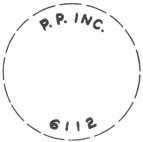
I have an unmarked Lapp U-634B with a very clear Kiln loader control number
(K 5) between the ears. I found these with others without the marking. Do you
know if these were used one per lot or what?
I also just got a couple of U-70 (thru-hole in dome), and have you been able
to find out what this is for yet?
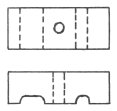
A few months ago when I went down into the basement, I happened to look up at
the ceiling, and I found a couple of wooden cleats (shown here full size)! Don't
get excited, as these were holding the wires from the outside phone tap. Also,
my house is only ten years old! I wonder how many of these the telephone company
used, and how many other wooden cleats have been produced.
Mathew Grayson
Roslyn, N.Y.
- - - - - - - - -
Dear Mathew:
It's simple. I just goofed by forgetting to put those P.P. Inc. dry press pin
type markings in the book. There are several varieties and combinations of
these, two of which are shown above. The U-31 pony is their #6109, and the U- 56
exchange is their catalog #6119. The small marking at left above is straight
across the crown top, and versions of the other one are circular around the
crown top.
From Lapps I have seen at utilities and in collector batches, I'd say they
used the K numbers on only a portion of each lot, maybe just several on each
kiln car shelf just for later identification after firing.
No ideas yet why the holes in types like U-70. An O-B employee last year gave
we his recollections on it, but it sounded so implausible that I chose to ignore
it. If someone back east could somehow manage to go through the right files at
the SCEL building at Ft. Monmouth, he would find the answer to this and many of
our questions on other Signal Corps insulators. Letters there reach buck
passers!
Yes, theme wooden phone tap cleats are modern, if not still current. I
believe their origin was Signal Corps, as are also quite a variety of wooden
knobs with designations in army stores catalogs as "trench knobs".
Jack
Several times in the past we have mentioned the large number of independent
users of all insulator types, and that what collectors see in all their travels
is such an extremely small percentage of usage in all other areas. Styles which
are very uncommon in collector hands or which may still be unreported types
could well be standard items with dozens of users where we just haven't been.
Reproduced below is a summary of the utilities listed and described in the
81st Edition of the "Electrical World Directory of Electric Utilities"
1973, McGraw-Hill, Inc.
Also keep in mind that many of these utilities bought up many of the earlier
ones or are the result of merged companies. And don't forget to add the
countless trolley companies, railroads, mines, factories and telephone companies
that all used porcelain insulators in great variety and quantity.
| UNITED STATES |
|
| 12 |
Non-Operating Holding Companies |
| 25 |
Wholesale Generating
Companies |
| 11 |
Service Companies |
| 11 |
Divisions |
| 274 |
Investor-Owned Companies |
| 1,769 |
Municipal Systems |
| 923 |
Rural Electric Cooperatives |
| 58 |
Public Power Districts |
| 7 |
Irrigation Districts |
| 40 |
U.S. Government |
| 9 |
State-Owned Systems |
| 1 |
County Systems |
| 2 |
Mutual Systems |
| 3 |
Transmissions |
|
|
| U. S. POSSESSIONS |
|
| 2 |
Government Authority |
| CANADA |
|
| 2 |
Holding Companies |
| 5 |
Wholesale Generating Companies |
| 1 |
Service
Companies |
| 13 |
Investor-Owned Companies |
| 410 |
Municipal Systems |
| 9 |
Provincial Power
Systems |
Dear Jack:
Regarding the radio lightning arrestor which you could not fully Identify
(see November Porcelain News), this is undoubtedly the MUTER CO., Chicago, and
this company was In the radio parts business back in the 1930's.
... I recently got a whole bunch of new wiring cleats (#334 types) including
DAVIDSON, A.S.P.Co., P.P. INC. in case you know of any buddies who want to swap
on these.
Walt Lehnert,
Minneapolis

Janet Sievert (Cupertino, Col.) sent photo of a pretty pin type similar to
U-642 and which has a very clear marking as shown here. This is a new one for
Canadian Porcelain Co. and, like the one shown on page 10 of the May 1974 issue
of Crown Jewels, the C in the marking is essentially completely closed. Note
the fancy serifs on the letters.
This in C.P. Co.'s catalog #408 with the smaller grooves and #845 with bigger
grooves -- both having a 1-3/8" pin hole. They first cataloged these in
1916. After about 1940, they also made the #845 style with standard 1" pin
hole as their #2300 and with sanded hole as their #6838.
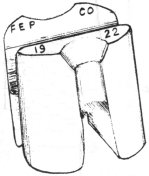
Dear Jack:
This brown porcelain has very deep grooves all around and is marked as shown.
What in it? Made by whom? When? Where? It's a strange one to us, and we'd like
to hear from anyone about this.
Mr. & Mrs. F. S. Summers
Arcata, Cal.
- - - - - - - - -
This in a circuit "break knob" and is used to break circuits at
desired points such as in series street light circuits. This specific design was
originated by Pass & Seymour, Syracuse, N.Y. and is covered by their patent
#476,828 of June 14, 1892 by Albert P. Seymour ("Circuit-breaking
Knob").
Letters patents expire in 17 years, and your specimen was made by Findlay
Electric Porcelain Co., Findlay, Ohio. They were in business 1911 to 1927. The
1922 number on the specimen is their catalog number of this item. They made
these in different glazes, and I have it in dark walnut brown, white and a light
orangy brown.
Jack

Roy Licari (Washington, D.C.) sent for my inspection a white pin type almost
identical to U-313 and which has a MADE IN GERMANY stamp (full size here) up in
the top of the pin hole.
This item was obviously made for export from Germany and possibly to this
hemisphere because of the 1" standard pin hole and being a direct copy of a
U.S. style
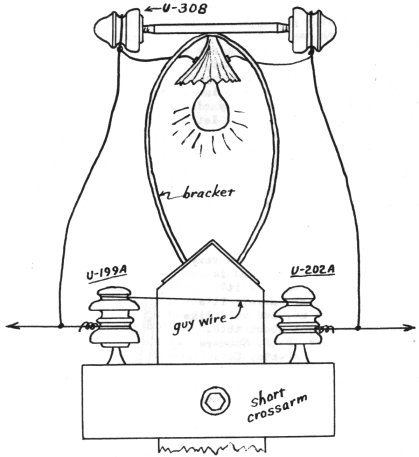
Dear Jack:
Frank Donnelly's letter in the October issue reminded me that I have long
been meaning to write about a non- telephone application for porcelain
transpositions. I'm enclosing a rough sketch, only from memory, of a series arc
light installations once in use at the P.R.R. roundhouse in Ebernezer, N.Y.
Since this yard was abandoned and the wires removed, somebody has taken all the
transpositions.
Note that the tramps in use here were to afford a means for removing
torsional stresses in the crossarms by guying together the tops of the tramps
with the extra groove at their tops. This could also be done with other
multigroove styles such as the Hi-Tops, but these were all installed many years
before the Hi-Tops were designed in the 1930's Dan Rider,
Buffalo, N.Y.
- - - - - - - - -
Dear Dan:
Yes, any mickey mouse scheme which requires four pin type
insulators on a pole top just to hang one arc lamp certainly deserves
recognition!
Jack
|
